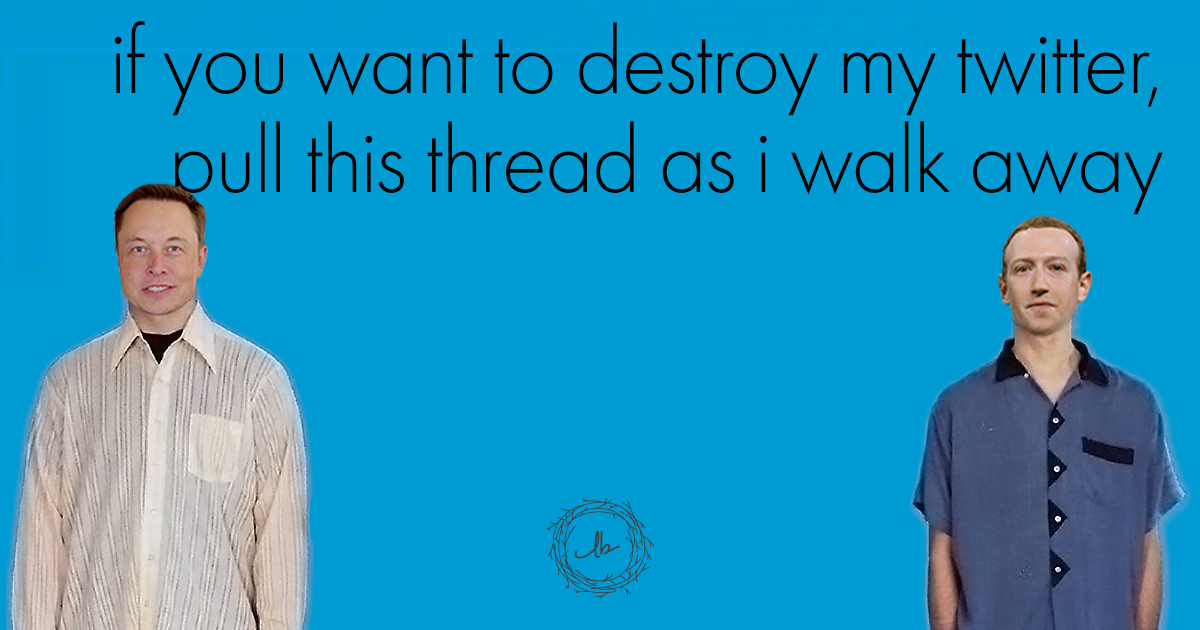“Change is inevitable. Change is constant.” Two-time British Prime Minister Benjamin Disraeli said that. He witnessed the establishment of the modern conservative party, the acquisition of Suez Canal shares, and the resurgence of the Russian-Turkish conflict. He did NOT, however witness Elon Musk challenging Mark Zuckerberg to fisticuffs.
The Twitter/X/Threads story is not brand-new news. The dust is starting to settle, which means we’re finally able to see what’s actually happening. First, let’s address a few of the questions we’re hearing from both businesses that utilize our social media marketing strategy and random people at soirées:
- Do I need to start calling Twitter “X”?
No. Everyone will know what you mean if you still say “Twitter.” If the X hangs around long enough, there will be a certain point when you’ll hear people referring to it that way, and you will know the time has come. If, at some point in the future, you say “Follow me on Twitter,” and someone replies, “You mean X?” but they don’t have a facetious twinkle in their eye, that will be the time to change. - Should I update the logo on my website from the Twitter bird to the X logo?
Yeah, go for it, but only if you want. We did. X has released a branding kit for the new logo, so it’s accessible. Caveat: If your website’s social media icons are cooked into the platform through a fixed widget (Hubspot), you might need to wait for the platform to add it. Second caveat: The favicon on the X website is still the Twitter bird. The URL is still twitter.com. That’s all. - Should I still call them Tweets or do I call them…something else?
Yes, please continue calling them tweets. - Do I REALLY need to set up a Threads account? Say it ain’t so!
Not necessarily. We’ll dig into the details a bit further down. We discussed it at Little Bird, because let’s be honest – in an ideal world, it basically serves as a secondary Twitter channel. The general feeling after the first month was that the platform might be fizzling, but truly, it could go either way.
The Relevant Background Info
If you’re not up to date with everything we just covered, please read on and we’ll clear it all up. We’re not going to do a full history. Here are some important highlights:
Twitter was founded in 2006 by Jack Dorsey and some other dudes. By 2010, they had 40 million users (monetizable daily active users, that is), and that number grew pretty steadily through 2022, when it hit somewhere around 400 million. That growth included sizeable jumps in 2019 and 2020, when Twitter was both an informational channel for public health issues and a much-needed social connection during the pandemic lockdown.
But what happened in 2022, you ask? Tesla CEO and world’s-richest-man Elon Musk bought it. Why did he do that? We don’t really know. First he said he’d like to own it, and started some paperwork. Then he said “wait, not really,” and then the Twitter people were like, “no takebacks.” Following the acquisition, he fired/laid off all the executives and half the staff, started charging for account verification (the blue checks), did some censorship-type stuff, put a cap on how many tweets could be posted per day, and got into loads of fights with Twitter users and employees through the platform. Current numbers show that Twitter users have dropped back down to 353 million, and projections are showing 335 million next year.
The Enigmatic Shift of Twitter to X
In July of this year, Musk announced that he was changing the name from Twitter to X. WHY? He said (in a Tweet, of course) that he thought the X would “embody the imperfections that make us all unique.” Does that mean something to you? This is pure conjecture, but follow us: Tesla Model X. Space X. X.com was the domain of the banking app Musk owned that later became PayPal. In 2017, Musk bought X.com back. It’s a Sesame Street story. This man loves the letter X.
While this rebranding may appeal to a niche audience seeking a certain modernity, a large portion of the platform's loyalists find it disorienting. This sentiment is palpable as you navigate through X, with a torrent of posts—humorous, critical, nostalgic—highlighting users' mixed feelings about the transformation.
Here lies the twist: Despite the intent to start afresh, the spirit of Twitter seems reluctant to fade. This duality poses intricate challenges for businesses. They now operate in a space where the brand's new identity (X) and its legacy (Twitter) are in an unprecedented tug-of-war. For B2B businesses who rely on Twitter for strategic social media connectivity, industry updates, and thought leadership, there are many questions about best practices, platform longevity, and tactical shifts moving forward.
The Dazzling Rise of Threads
July was a busy month. While Musk was announcing Twitter’s name change, Facebook/Instagram/Meta CEO Mark Zuckerberg announced a new platform named Threads. Users downloaded the app, opened the app, and exclaimed, “This is Twitter!” The similarities are striking. Musk noticed too, but that was partially because of the staggering 100 million users Threads garnered within its first week.
😂
— Elon Musk (@elonmusk) July 6, 2023
Its meteoric rise, in part, can be credited to its strategic alliance with Facebook and Instagram. By integrating directly with an app suite of this magnitude, Threads had a head start, allowing it instant access to a massive audience pool. However, its success isn't merely derivative. Threads brings a fresh perspective to content consumption, through a peculiar algorithmic design. It is not exactly chronological, and it seems to blend content from followed accounts with content from arbitrary(?) accounts. It's a departure from the familiar, and while it has sparked intrigue, it's also birthed skepticism.
The Dazzling Plateau of Threads
Early Threads feedback indicated higher rates of engagement per post than Twitter, but daily use of the app declined sharply, and nearly immediately. By August, most reports cited a nearly 80% drop in daily users. Will the platform suffer the fate of Google+? This isn’t certain. Recently, it appears that new integration efforts between Threads and Instagram may be helping funnel a dwindling audience back to the platform, as Instagram’s main feed now features periodic Threads posts that link directly to the other app. The platform offers native post scheduling features, but most content management systems (like Hubspot or Hootsuite) have not included a direct way to connect with Threads yet.
The Notable European Absence
Threads' success narrative, however impressive, contains a conspicuous gap: Its non-presence in Europe. For a continent that's a pivotal player in the tech landscape, the absence of such a burgeoning platform is both intriguing and baffling. Is it the shadow of potential EU regulations that's inhibiting its launch? Or could it be concerns related to data protection and user privacy? Europe's absence from Threads' global footprint doesn't just limit its potential reach but also hints at the complexities and challenges that may lie ahead, especially in light of the EU's rigorous stance on digital rights and data protection.
The Ongoing Musk-Zuckerberg Feud
Adding another layer of intrigue to this already complex business narrative is the equally complex feud between Musk and Zuckerberg. To some, it might seem like pure tabloid fodder – a petty clash between two of the tech industry's most prominent figures. However, there is evidence that the rivalry goes beyond personal animosities. Like or loathe them, both Musk and Zuckerberg are visionaries, each with their unique perspectives on the future of tech and its role in society. While Musk frequently emphasizes the potential perils of unchecked AI and advocates for more cautious advancements, Zuckerberg's empire is built upon maximizing the capabilities of digital platforms and leveraging data. Both Twitter and Facebook have been at the center of controversy regarding political elections, the boundaries of free speech and misinformation, advertising ethics, and the privacy of their users.
 This rivalry isn't just about egos or past grievances; It represents two divergent paths for the future of the digital realm. Every move, acquisition, or innovation they champion is not just a business decision but a move in a grand chess game for the soul of digital innovation. As both X and Threads battle for market share, it's impossible not to view this in the light of their creators' ongoing duel.
This rivalry isn't just about egos or past grievances; It represents two divergent paths for the future of the digital realm. Every move, acquisition, or innovation they champion is not just a business decision but a move in a grand chess game for the soul of digital innovation. As both X and Threads battle for market share, it's impossible not to view this in the light of their creators' ongoing duel.
Traversing From X to Threads: A Business Perspective
The transformation of Twitter into X and the rollout of Threads has left businesses today at a major crossroads. The renaming of an established platform like Twitter isn't just a superficial change – it impacts user behaviors, platform algorithms, and brand perceptions. Businesses now have to reconsider if the strategies they employed on Twitter remain effective on X. The platform's shift, coupled with the significant amount of critique and resistance from users, makes it imperative for businesses to be agile, recalibrating their tactics as they receive feedback.
On the other hand, Threads, despite being a newcomer, has managed to establish itself as a significant player very rapidly. But its success doesn't eliminate the uncertainties that come with it. For instance, its unorthodox algorithmic approach complicates the familiar and strategic posting strategy that works on Twitter. Likely though, the baby algorithm just needs time to grow, and future iterations will continue to adapt to what users most enjoy (i.e. those that keep eyes on the app longer).
While that works itself out over time, businesses using social media for marketing must now experiment and find novel ways to ensure their content remains visible and impactful. The challenge isn't about being present on every platform, but rather understanding the nuances of each, strategizing effectively, and ensuring brand consistency while doing so. And whatever you do, do not come undone.
Social Media Marketing Strategy Amidst Digital Transformations
The digital realm is in a constant state of flux. Platforms rise and fall, algorithms evolve, and user preferences shift. However, amidst this whirlwind, a core principle remains unaltered – the essence of genuine, impactful engagement. Platforms, in essence, are tools, mediums through which messages are conveyed. Whether it's Twitter, X, Threads, or the next sensation that's yet to hit the market, the effectiveness of a message doesn't solely lie in the platform it's delivered on but in its authenticity, relevance, and the value it provides to its audience.
At Little Bird Marketing, we understand these dynamics. We're not passive observers, watching from the sidelines as the digital landscape evolves. Instead, we're active participants, continually refining our strategies, understanding platform nuances, and above all, emphasizing the importance of genuine engagement. As platforms come and go, our mission remains: To guide and empower businesses in navigating these changes, ensuring that their voices are not only heard, but also resonate.





Let Us Know What You Thought about this Post.
Put your Comment Below.